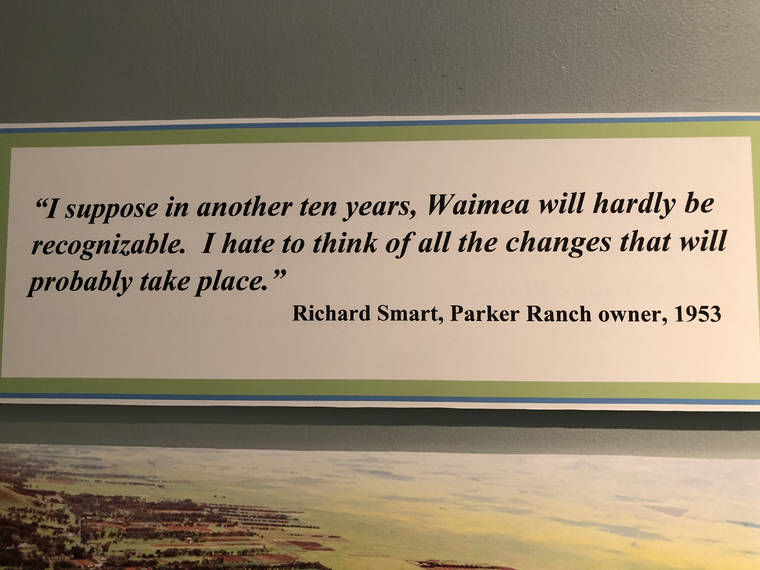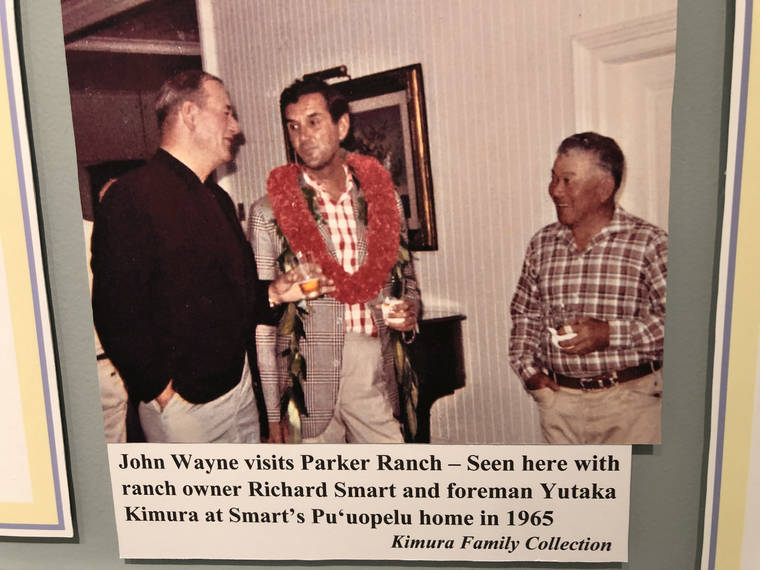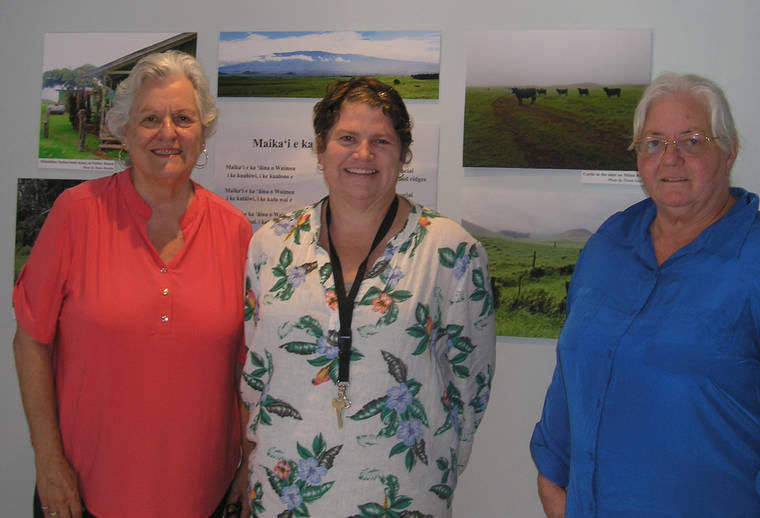Detailed exhibit honoring history of Waimea opens in Honokaa



HONOKAA Piecing together an exhibit on a place as unique as Waimea takes months to prepare.
HONOKAA — Piecing together an exhibit on a place as unique as Waimea takes months to prepare.
As well it should.
North Hawaii’s most beloved community is rich in history. Vast are the personalities who trekked to visit, names like John Wayne and dignitaries like King Kamehameha III.
Weaving together of a visual narrative that documents it all — from the Parker Ranch to Camp Tarawa — takes tireless, detailed work.
And it’s paid off.
An exhibit honoring the history of Waimea opens this week at the North Hawaii Education and Research Center’s Heritage Center in Honokaa. Curated by Heritage Center Coordinator Dr. Momi Naughton, it presents a meticulously researched and thoughtfully organized history of Waimea from early times through the 1970s.
“I’ll feel as if the exhibit is a success if someone says, ‘I didn’t know that,’” Naughton said of what she hopes guests take away.
In doing the work, Naughton has drawn on her own extensive knowledge of the area as well as family information, timelines and artifacts provided by local old-timers. Also included are photos she took when living and working in Waimea in the 1970s.
Titled, “Maika’i e ka ‘Aina o Waimea” the display’s name comes from a song composed as a school-wide chant for Waimea Middle Public Charter School in 2007-2008.
“The song, which celebrates Waimea as a special place with mountains and steams from upland to the sea, seemed like the perfect name for our exhibit,” Naughton said.
An opening celebration will be 4:30 p.m. Thursday. The free event will feature refreshments and live music by Hawaiian musician Ikua Purdy, a great-great-grandson of the famous Waimea paniolo.
The exhibit is set up by categories that literally and physically organize the information. Each section has readable and relatable text accompanied by relevant historic photos.
The categories include Moolelo Oral Traditions, Aina Land, Forests of Waimea, Change Agents (the first cattle in 1793 and introduction of horses in 1830), Parker Ranch, Alii Visits to Waimea, Makahikilua, Churches and Missions, Parker Family Homes, Early Waimea Homesteads and Coastal Development.
In all categories, visitors have the opportunity to learn fun and interesting facts.
A section about Waimea’s forests, for example, discusses pulu, the red hair-like covering for young frond of the hapuu fern. Pulu fibers were harvested and exported to the western U.S. for use as stuffing in pillows and mattresses. By 1880, however, the use of pulu was replaced by cotton and other more durable fibers.
Many alii visited Waimea, in part to visit the prestigious Parker family and also to attend Imiola Church. They included Gov. Kuakini, King Kamehameha III and his wife Kalama, Alexander Liholiho Kamehameha IV, Princess Likelike, Queen Kapiolani, Princess Liliuokalani and Queen Emma.
Princess Ka’iulani visted Samuel Parker’s home at Mana in January 1899.
The princess had been ill for several months after getting wet while horseback riding on Oahu. Her doctor suggested she visit Waimea as he thought the mountain air would be helpful. Sadly, while horseback riding near the Parker home the young princess was caught in the rain and mist and became even more ill. She returned to Oahu and died one month later at age 23.
Deservedly, a significant section of the exhibit is devoted to World War II and the impact of Camp Tarawa on Waimea.
In 1943, the 2nd Marine Division and support personnel set up Camp Tarawa in Waimea.
The camp was to become the largest Marine training site in the Pacific and over a two-year period, the sleepy little town of Waimea with a population of just under 500 and no public electricity, swelled to an encampment hosting 40,000 men.
Exhibit-goers will also learn little known facts such as that at one time, all the land bordering beaches in the area was owned by Parker Ranch. And Father Damien spent time in the Waimea area prior to ministering at Kalaupapa. Damien built the area’s first Catholic Church in 1868.
Visitors will also learn about Ira Hayes, a Pima Indian stationed at Camp Tarawa who was one of the six soldiers to hoist the flag at Iwo Jima.
Appropriately, the exhibit includes Parker Ranch Owner Richard Smart’s quote on the meaning of Waimea, and his answer to the question once and for all, “Is the Town Waimea or Kamuela?”
“Waimea, which means reddish water, a name descriptive of our natural water here, is indeed the true and proper name of our village — no other. This is borne out by the ancient hulas, songs, meles and chants which describe Waimea — never Kamuela,” Smart said. And, “Today we see Kamuela and Waimea both used in businesses and for landmarks in town. However, the town is Waimea and the post office is Kamuela.”
Smart seems to have been spot on as well with his quote from more than 55 years ago regarding future development:
“I suppose in another 10 years, Waimea will hardly be recognizable. I hate to think of all the changes that will probably take place.”
Critical to the success of the Waimea exhibit were the contributions by Naughton’s team: graphic artist and researcher Marie Kinchla and University of Hawaii graduate student Nicole Garcia.
Other important contributors were the Heritage Center’s weekly Talk Story Gang, comprised of Jimmy Silva, Gary Repozo, Charlie Kimura, and Donnie and Paula DeSilva.
Also helpful were contributions by local historian Dr. Billy Bergin and unsung historian Lucille Brundage, who served as a secretary and stenographer for Parker Ranch and the Hawaii Meat Company for 31 years. She did extensive research in the state archives and put together binders of information which helped with the development of the exhibit.
Additional information for the exhibit came from historical articles written for the Waimea Gazette and anchored by contributions from local writers including Pat Godfrey, Maile Melrose Mollie Sperry, Tina Clark, Pete Hendricks, Patti Cook, Nancy Piianaia, and Ma’ata Tukuafu.
The Waimea history exhibit will be in place at the NHERC Heritage Center for two years. The exhibit is free. Visiting hours are 9 a.m. to 4 p.m. Monday through Friday and 9 a.m. to 1 p.m. on Saturdays.
Info: email nherc@hawaii.edu or call 775-8890.


